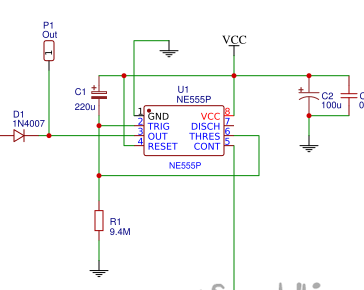I assembled the circuit, I seemed to be satisfied, but for more than 40-50 minutes I could not squeeze out of it, and calmed down, seemingly thinking that this time would be enough for the procedure to kill mosquitoes, but it turned out, no, I experimentally determined that it took at least 2.5 hours (for a stable introduction of Komarinsky, at a steep peak). I began to study the Ne555, or rather, twist the circuit in the excellent online simulator for this http://www.falstad.com/circuit/, and discovered that if you apply microcircuit to the 5th leg, the voltage is from 0 to the supply voltage, we can significantly affect timer response time. Later I climbed into the documentation of this excellent microcircuit, and found confirmation of this, the 5th foot for this was created to influence the divider of the timer comparator, that is, by applying one voltage or another to the 5th leg of the timer, we can control the shutdown interval. the first thing that came to my mind was to connect a controlled voltage source to the fifth leg. but in the simulator it suddenly appeared that this voltage yes affects the time interval, but logarithmically, that is, up to 1 volt, it greatly increases this interval, and then with a small scatter. For my purposes, it’s necessary to apply a voltage with an amplitude of 0.5 volts, and then an idea came to my mind: what if I apply it to the 5th leg through the diode from the output of the microcircuit, but I connected the output of the microcircuit to the anode, well, by logic, it should be work, but nothing happened, that is, the time interval did not change, from despair I turned the diode the other way around and Eureka, I got the desired effect on the interval, it became 3.6 times longer, that is, not 40 minutes but 2 hours 20 minutes , this is in the simulator, the practice turned out to be even more generous, the timer went off after 2 hours 40 minutes, time p works stably. Now the mosquitoes are also dying, but with the seller of the fumigant fluid we see less often, and the denyuzhka remains in my pocket, I will direct this extra money to buy this miracle microcircuit. Here is a circuit with an additional diode circuit at the output.

